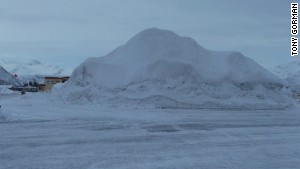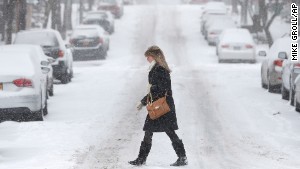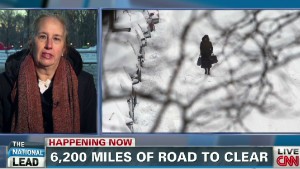Editor's note: Tony Gorman is news director for KCHU Terminal Radio in Valdez, Alaska, which covers the Prince William Sound and The Copper River Valley. He has also reported on issues in southwest and southeast Alaska during his almost six years in Alaska.
(CNN) -- The northeast region of the United States got pummeled with snow. It was bad, really bad. According to the National Weather Service, nearly 2 feet of snow fell north of Boston while other parts of the Northeast received as much as 18 inches. That was good enough to shut down schools, cancel flights in the region and declare snow emergencies.
For my city, Valdez, Alaska, 18 inches of snow is just another day; schools operate, companies stay open and people go about their daily routines.
The Prince William Sound community, where the Trans Alaska Pipeline and the Richardson Highway end, tops the list as the snowiest city in United States, according to The Weather Channel. It averages 326.3 inches of snow each year and has gotten as much as 556.7 inches in one season. Yet the city manager has said that declaring a snow emergency would be "humiliating."
 Tony Gorman
Tony Gorman How does a town with a population of nearly 4,000 cope with all that snow?
The plows go out in the early mornings trying to clear the snow before locals head to work and school. It's not smart to be driving during snow removal. Sometimes you can drive head-on into the path of a snowplow. Then there are the berms, that barrier of unplowed snow in the middle of the road. Unless you have an SUV or a truck that's high off the ground, making that left turn isn't advised. Those two obstacles can turn your drive down the street into an adventure.
During this time, locals are asked not to park in the streets, at risk of getting a ticket.
 America's snow capital piles some of the plowed snow into a snow cone in a parking lot near city hall.
America's snow capital piles some of the plowed snow into a snow cone in a parking lot near city hall. Where is all that snow stored? The city uses its local parks as snow dumps. They're green during the summer and white by winter. Barney Meyring Park is by far the biggest park strip in town. There are playgrounds, basketball courts and a large open space for dogs to run around in the park. The south end was used as a temporary football field last season. All those assets are hidden beneath several feet of snow during the winter.
Next to city hall is another snow storage site, a parking lot that is turned into a two-story high snowcone every winter.
Those are just the public and commercial places. During that quick trip to the store, now a little longer because you're dodging berms and snowplows, you will notice people with snowblowers in the driveways and on the roofs. Some residents have their own snowplows. Most just push the snow to the sidewalks and let the city crews do the rest.
For me, Valdez was a shock. I grew up in Mississippi: If 2 inches of snow hit the ground (stick or melt), there was no school for that day.
 Brutal snow storm bears down on U.S.
Brutal snow storm bears down on U.S.  Did de Blasio pass the snow test?
Did de Blasio pass the snow test?  See reporter faint in snow, then...
See reporter faint in snow, then... I got my first taste of a REAL winter when I ventured off to college in Nebraska. I remember sitting in the dorm and watching TV when the first snowstorm of the school year came. I thought for sure classes would be canceled. Every educational institution in the area canceled classes, except mine. Still in shock from not seeing my college's name scroll across the bottom of the screen, I bundled up and headed to class.
When I moved to Alaska, I had the same thoughts about the Last Frontier as everyone else: It's cold, with igloos and polar bears. I thought my Midwest experience had prepared me for the elements of Alaska. My first winter in the state was in Wrangell, a town of more than 2,300 people in Southeast Alaska. As in the rest of the region, it rains much of the time. I saw plenty of snow during my two-year stint there, but it was nothing compared to Valdez. People warned me, but I didn't listen. I thought I was good with a nice coat, gloves and a decent pair of boots. It has been three years since I've moved here and I still have a sort of love-hate relationship with the snow.
One thing is clear: It takes a lot of snow for the city to shut schools and businesses. That happened during the 2011-12 winter. After a slow start, Alaska's south central region was pummeled from December through February.
It got really bad for Valdez's regional counterpart, Cordova. With the snow dumps full, that city declared a state of emergency and called in the Alaska National Guard to clear out most of the snow.
Valdez officials came close to going in that direction after schools and businesses were closed because of excessive snow loads on roofs. Valdez City Manager John Hozey said it best during rounds of meetings with the public and other leaders: "Valdez prides itself on being the snow capital in the world. And for us to declare a state of emergency would be humiliating."
Officials in Valdez didn't call in the National Guard, but relied on outside help with snow removal. It brought in workers from other parts of the state to help cut blocks of snow off the roofs of schools and businesses. A shovel that season was the most valuable tool in town.
That winter saw seasonal records broken throughout the state. Anchorage bragged about breaking its seasonal record with 134.5 inches. Valdez's response: "Good for you." It received 152.2 inches in the month of December and closed out with 438.3 inches for the season. (Valdez's record for snowfall in a season was set during the 1989-90 winter with 556.7 inches.)
I've had plenty of days where my sense of accomplishment from digging out my car from a previous snowfall is taken away minutes later by the next. Digging out my radio station's satellite dishes has become a regular winter chore.
I can get by without studs on my tires, but they sure would make driving easier in those slippery areas. One of these days, I'll get used to the all the snow here in Valdez.
Follow us on Twitter @CNNOpinion.
Join us on Facebook.com/CNNOpinion.
{ 0 comments... read them below or add one }
Post a Comment